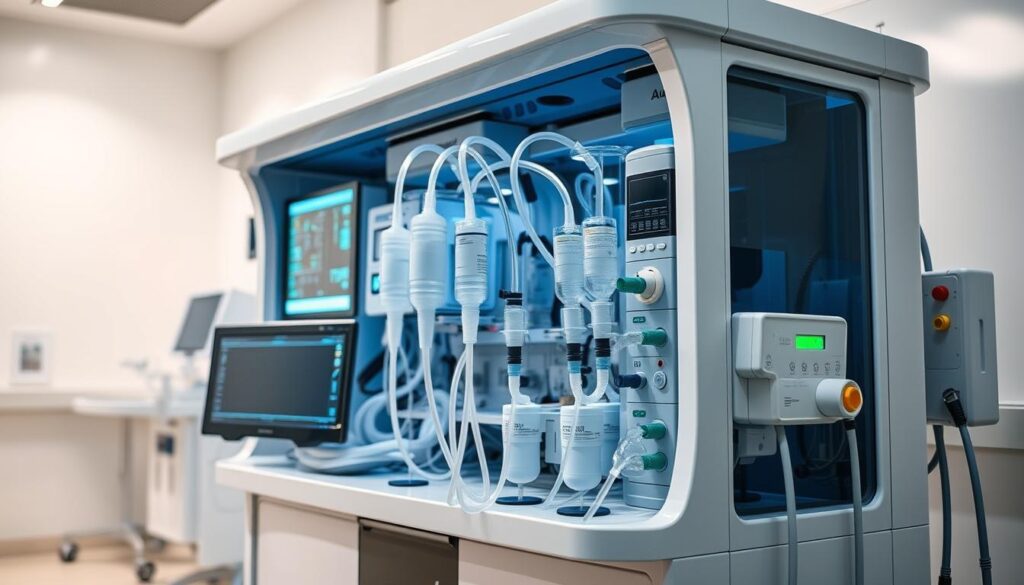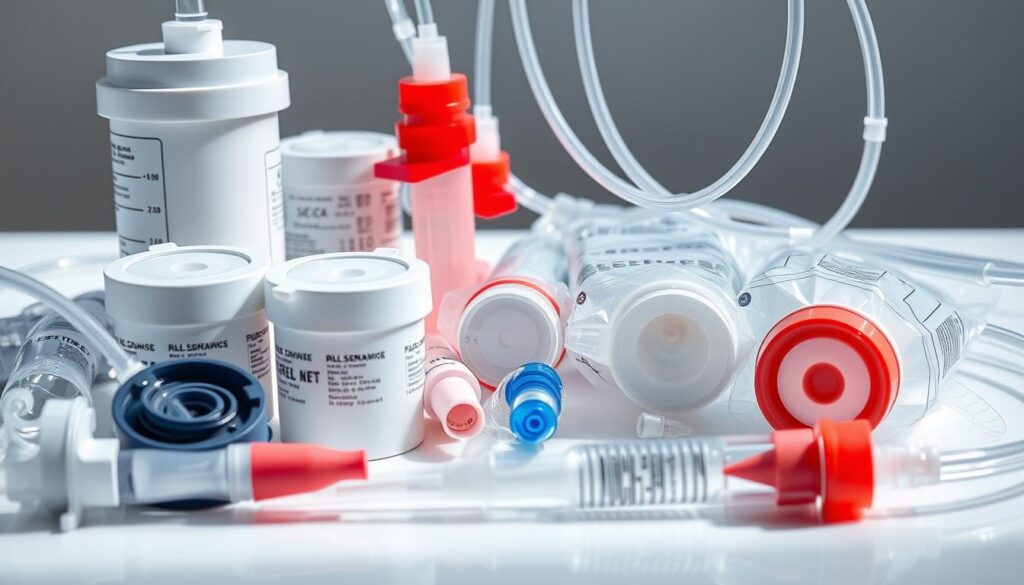Dialysis machines are a lifeline for those with kidney disease. They are vital for patients with end-stage renal disease. These machines filter waste, toxins, and excess fluids from the blood.
This helps keep the body balanced and functioning. Dialysis has changed how we treat kidney failure. It offers hope and improves life for millions worldwide.
These machines are key in modern healthcare. They save lives and help people with chronic kidney disease get better.
Key Takeaways:
- Dialysis machines are essential medical devices for patients with kidney failure
- They perform the vital functions of damaged or failed kidneys by filtering waste, toxins, and excess fluids from the blood
- Dialysis has transformed the treatment of kidney disease, offering hope and improving the quality of life for millions of patients
- These advanced machines have become an indispensable part of modern healthcare, saving lives and providing a pathway to better health
- Understanding the role of dialysis machines is crucial for individuals facing the challenges of kidney disease
What Are Dialysis Machines and How Do They Work
Dialysis machines, also known as hemodialysis equipment or artificial kidneys, are vital for people with kidney failure. They filter waste, excess fluids, and electrolytes from the blood. This makes them essential for the health and well-being of those with kidney issues.
Basic Components of Dialysis Equipment
Dialysis machines have several key parts that work together. The main parts include:
- Blood pump: This circulates the patient’s blood through the dialysis system.
- Dialyzer: Also called a “kidney,” the dialyzer filters waste and excess fluids from the blood.
- Dialysate fluid: This solution helps exchange substances between the blood and the dialyzer.
- Monitoring systems: These ensure the dialysis machine operates safely and efficiently.
The Filtration Process Explained
The dialysis process starts with the blood pump drawing blood from the patient. It then directs the blood into the dialyzer. Inside the dialyzer, the blood flows through a semi-permeable membrane.
This membrane allows waste, excess fluids, and electrolytes to exchange between the blood and dialysate fluid. After filtration, the blood is returned to the patient’s body, ready to resume its functions.
Types of Dialysis Systems
There are two main types of dialysis systems: hemodialysis and peritoneal dialysis. Hemodialysis uses a machine to filter blood externally. Peritoneal dialysis uses the patient’s abdominal lining as a filter.
Each system has its own benefits and considerations. They cater to the individual needs and preferences of kidney patients.
Dialysis machines are crucial in managing kidney disease. They have innovative components and filtration processes. Understanding these devices helps us appreciate the advancements in renal replacement therapy.
They play a vital role in improving the quality of life for those with kidney failure.
The Evolution of Renal Replacement Therapy
Nephrology has seen big changes in how we treat kidney failure. From simple devices to today’s advanced machines, dialysis has greatly improved life for those with kidney disease.
The story of dialysis starts in the 1940s. Willem Kolff, a Dutch doctor, made the first working dialysis machine, called the “artificial kidney.” This was a big step forward for treating nephrology treatment needs.
Over time, dialysis machines got better. New types like hemodialysis and peritoneal dialysis came along. Now, there are even machines you can use at home, changing how we treat end-stage renal disease.
Today’s dialysis machines have cool features. They include:
- Precise blood flow and fluid management systems
- Sophisticated monitoring and safety mechanisms
- Enhanced dialyzer and membrane technologies for more efficient filtration
These updates have made treatment better and more flexible. Patients now have more freedom in their nephrology treatment plans.
“The evolution of dialysis technology has truly been a game-changer in the field of end-stage renal disease management, transforming the lives of countless individuals worldwide.”
The future of treating kidney disease looks bright. New ideas like artificial kidneys are on the horizon. They promise even better nephrology treatment options for all.

Essential Components of Modern Dialysis Machines
At the heart of effective dialysis treatment are the intricate components that work in harmony to purify the patient’s blood. From the sophisticated blood pump to the state-of-the-art dialyzer and membrane technology, these elements come together to create a safe and efficient dialysis experience.
Blood Pump and Circulation System
The blood pump is the driving force behind the dialysis process, ensuring a steady and controlled flow of the patient’s blood through the system. This carefully engineered component, along with the comprehensive circulation system, plays a crucial role in maintaining the appropriate pressure and velocity required for effective blood purification.
Dialyzer and Membrane Technology
The dialyzer, often referred to as the “artificial kidney,” is the primary filtration unit in a dialysis machine. This advanced device utilizes cutting-edge membrane technology to remove waste products and excess fluids from the blood, while preserving the essential components necessary for the patient’s well-being. The performance of the dialyzer is a critical factor in the success of dialysis consumables and blood purification devices.
Monitoring and Safety Features
Modern dialysis machines are equipped with sophisticated monitoring and safety systems that ensure the patient’s safety throughout the treatment process. These features continuously track vital parameters, such as blood flow, pressure, and temperature, and automatically adjust the machine’s settings to maintain optimal performance and prevent any potential complications.
The seamless integration of these essential components is what makes today’s dialysis machines true lifesavers for individuals with kidney disorders. By leveraging the latest advancements in technology and materials, dialysis providers can offer patients a safe, comfortable, and effective treatment experience.

| Component | Function | Importance |
|---|---|---|
| Blood Pump | Ensures a steady and controlled flow of the patient’s blood through the system | Plays a crucial role in maintaining the appropriate pressure and velocity required for effective blood purification |
| Dialyzer | The primary filtration unit that utilizes membrane technology to remove waste products and excess fluids from the blood | A critical factor in the success of dialysis consumables and blood purification devices |
| Monitoring and Safety Features | Continuously track vital parameters and automatically adjust the machine’s settings to maintain optimal performance and prevent complications | Ensures the patient’s safety throughout the treatment process |
Life with Dialysis: Treatment Schedules and Requirements
Living with dialysis means following a strict routine and managing your health well. Patients usually go for dialysis treatments a few times a week. These sessions can last for hours, helping to keep the kidneys working right and preventing waste buildup.
Dialysis centers are key in giving patients ongoing care and support. These places have skilled doctors and nurses who watch over the dialysis process. They make sure patients are safe and adjust treatment plans when needed. It’s very important to stick to the treatment schedule, as skipping or delaying sessions can harm your health.
Patients also need to follow special diets and drink the right amount of fluids. This helps avoid problems like imbalances in electrolytes or too much fluid in the body. By working with their healthcare team and making changes in their lifestyle, people on dialysis can still live happy and healthy lives.
FAQ
What are dialysis machines and how do they work?
Dialysis machines are key medical tools for people with kidney failure. They clean the blood by removing waste and balancing fluids and salts. This is crucial for those with severe kidney disease.
What are the different types of dialysis systems?
There are two main dialysis systems: hemodialysis and peritoneal dialysis. Hemodialysis uses a machine to filter blood. Peritoneal dialysis uses the patient’s own membrane to clean the blood.
What are the key components of modern dialysis machines?
Modern dialysis machines have a blood pump, dialyzer, and monitoring systems. These parts work together to purify the blood safely and effectively. High-quality materials and technology are also important.
How often do patients typically undergo dialysis treatment?
How often dialysis is needed varies by patient. Most get treatment several times a week, for hours at a time. Sticking to the treatment schedule is key for health.
What is the role of dialysis centers in providing care for patients?
Dialysis centers are essential for patients with kidney disease. They offer the right equipment, medical care, and support. They also provide education and emotional support to help patients manage their condition.
